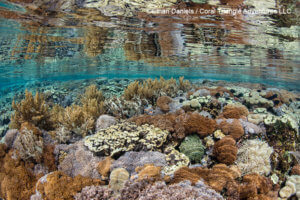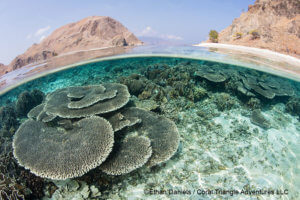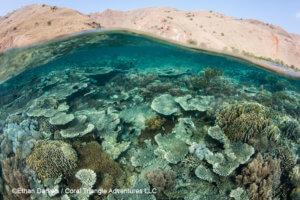
Snorkeling on thriving reefs in Komodo National Park
thriving
It has long been thought that thriving coral reefs, one of the most diverse and productive ecosystems, are among the most fragile natural systems on Earth. The myriad creatures that compose reef food webs live in a very small range of temperatures and require quite specific habitats, food sources, and reproductive cues. Thousands of delicate species, such as sponges, corals, hydroids, anemones, bryozoans, echinoderms, tunicates, and more, strive to settle and succeed in shallow water where prevalent sunlight drives the reefs’ energy input. After snorkeling for years through the Coral Triangle we’ve wondered whether we should consider these reefs truly “fragile” or are they more robust as a whole than it appears?
On Coral Triangle Adventures’ latest voyage through Komodo National Park we witnessed a plethora of amazing coral reefs growing within centimeters of the low tide line. Along with seagrass and mangrove habitats, large swaths of reef-building and soft corals served as home territories for hundreds of small fish species, from the tiniest of gobies, blennies, damselfish, anthias, butterflyfish, angelfish, etc., to the larger Giant Trevally, Giant sweetlips, Napoleon wrasse, and bumphead parrotfish. Wherever we explored among the volcanic islands between Flores and Sumbawa, we saw health and vitality, though sometimes in stages of succession.
Change over time is constant and continual, that is for certain, but over the 15 years of snorkeling in this region we have perceived the reefs within Indonesia’s protected areas have not only withstood the beginnings of climate change but they seem to be flourishing. Yes, there are times when we come across localized Crown of Thorns outbreaks or bleaching events but those same reefs have virtually all returned to their splendid amalgamation of vibrant marine life. Of course we craft our snorkel sites to be in areas away from human population centers where overfishing and damaged reef communities would be more expected.
So the debate of whether coral reefs are truly fragile or robust is still in question but we believe that the two terms are not mutually exclusive. Reefs can be both, depending on the definition of the two terms. From our limited perspective of snorkeling through these magnificent underwater gardens we see many delicate individuals that compose vigorous underwater ecosystems. These natural marine systems, which have a long evolutionary history, may suffer setbacks over short periods but there is definitely the tendency for resilience and rapid recovery when geographically situated away from large human settlements. Reefs may have the potential for survival as climate change proceeds, though undoubtedly reef communities will look different. This is not by any means an argument against working towards slowing climate change but you could say we’re reasonably optimistic after we have witnessed so many outstanding coral reefs throughout this most recent Komodo trip.
Our next Komodo departure is in Sept, 2021!



